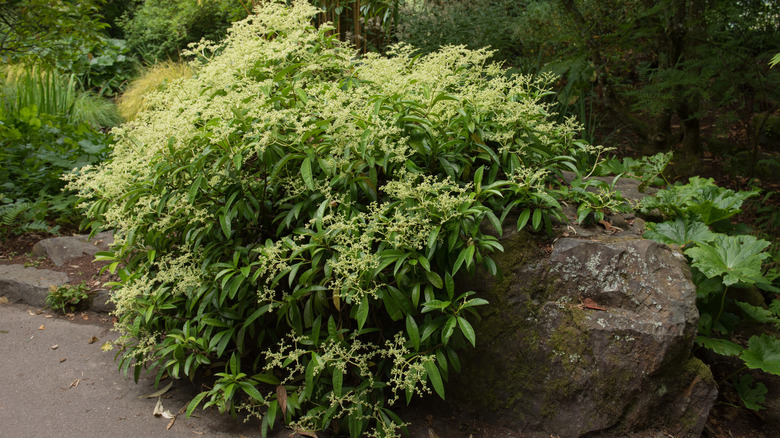The Evergreen Climber That Turns Your Garden Into A Pollinator Paradise
Climbing plants are a fitting option for adding vertical interest to your garden. If those climbers are also evergreen and appealing to pollinators, then that's even better. Unfortunately, some common climbing plants like English ivy (Hedera helix) are extremely invasive in the United States, making them poor choices for landscaping. Luckily, there are many good alternatives for invasive English ivy in your garden. One of the best and most beautiful pollinator-attracting evergreen vines is the climbing hydrangea (Hydrangea viburnoides).
Native to eastern Asia, climbing hydrangeas boast beautiful leathery, dark green leaves and clusters of star-shaped white flowers during the late summer and fall months. These blooms aren't just pretty; they're also a hit with bees and other pollinators. And the plant's year-round foliage ensures that your garden trellis will never look naked just because it's chilly out. Just be aware that climbing hydrangeas are self-clinging, so you may not want to grow them directly against buildings as they could cause damage. If you provide your plant with a trellis or arbor, then you shouldn't have any problems.
Caring for your climbing hydrangea in the landscape
Hardy in USDA zones 7 and up, climbing hydrangeas thrive in full to part shade and both sheltered and exposed areas, making them great additions to tranquil woodland gardens or virtually anywhere in your landscape. Unfortunately, climbing hydrangeas don't do well in containers, so you'll need to plant them directly in the ground. They can tolerate a range of pH levels and soil types as long as they are well-draining. They are also relatively drought tolerant, making them great options for gardeners following the xeriscaping trend. These hydrangeas do appreciate humus-rich soil, so consider amending with compost or fertilizer as needed.
With a mature height of around 12 to 20 feet, climbing hydrangeas are a perfect way to add verticality when growing a flourishing shade garden. Whether they're filling your yard with happy pollinators during the summer months or providing interest during winter, these vines are perfect for covering unattractive fences or adding pops of color to shady corners. They can cause skin irritation though, so be sure to wear your gloves and long sleeves when working with these plants.

